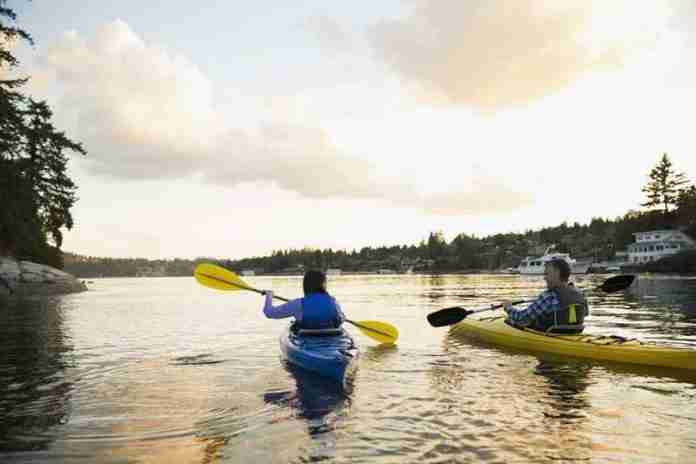Table of Contents
Welcome to the captivating world of kayak camping, where adventure, relaxation, and nature all converge into one thrilling experience. In this comprehensive guide, we will delve into everything you need to know about kayak as a beginner and how you can make your camping trip more enjoyable with it..
1. Choosing the Right Kayak:
Before embarking on your kayak camping journey, it’s crucial to select the right kayak for your needs. Consider factors such as stability, storage capacity, weight, and maneuverability. Sit-on-top kayaks are often a popular choice for beginners due to their stability and ease of use.
2. Essential Gear:
Besides your kayak, there are several essential items you’ll need for a successful kayak camping trip. These include a paddle, life jacket, dry bags or waterproof containers to store your gear, a tent, sleeping bag, camping stove, food, water, and appropriate clothing for the weather conditions.
3. Mastering Basic Kayaking Techniques:
As a beginner, it’s important to familiarize yourself with basic kayak camping techniques before setting out on your camping trip. Practice skills such as paddling strokes (forward stroke, backward stroke, sweep stroke), turning, bracing, and self-rescue techniques. Consider taking a kayak lesson or joining a guided tour to learn these skills from experienced instructors.
4. Planning Your Route:
Research and plan your route in advance. Check for any permits or regulations that may apply to the area you wish to explore. Look into weather conditions, tides, currents, and any potential hazards along the way. It’s advisable to start with shorter trips and gradually increase the distance as you gain experience.
5. Packing and Organizing:
When packing for your kayak camping trip, prioritize lightweight and compact items. Utilize dry bags or waterproof containers to keep your gear dry. Distribute the weight evenly in your kayak to maintain stability. Pack essentials such as food, water, first aid kit, navigation tools, and extra clothing.
6. Safety Precautions:
Safety should always be a top priority while kayak camping. Ensure you have a personal floatation device (PFD) that fits properly and is worn at all times. Familiarize yourself with basic water safety techniques and rescue procedures. Let someone know your itinerary and expected return time.
7. Leave No Trace:
Practice Leave No Trace principles to minimize your impact on the environment. Pack out all trash, dispose of waste properly, and avoid damaging vegetation and wildlife habitats. Respect any designated camping areas and follow any rules or restrictions in place.
8. Enjoying the Experience:
Kayak camping offers a unique opportunity to connect with nature and enjoy the serenity of the water. Take time to appreciate the surroundings, listen to the sounds of nature, and embrace the sense of adventure. Remember to relax and have fun!
Introduction to Kayaking
Definition of “Kayak Camping”
Kayak camping is a versatile water sport that involves paddling using a double-bladed oar and a small boat known as a kayak. The design of the kayak allows for a wide range of activities, including fishing, exploring, and, importantly for us, camping. Kaya is not just a form of transportation; it’s a way to connect with nature, strengthen your body, and discover new landscapes.

Benefits of having a Kayak on a Camping Trip
Combining ocean kayaking with camping can significantly enhance your outdoor experience. Kayak allows you to access remote camping spots that are otherwise unreachable by foot or car. It also offers an excellent opportunity for wildlife viewing, fishing, and simply soaking up the serenity of the natural environment. Additionally, kayak is a great aerobic exercise that strengthens the upper body and improves cardiovascular health. But most of all, it’s a fun, adventurous activity that brings joy and excitement to any camping trip.
Choosing the Right Kayak for Camping
Types of Kayaks
There are several types of kayaks, each designed for a specific use. For camping trips, touring kayaks and sea kayaks are the most suitable. Touring kayaks are designed for longer journeys on open waters, while sea kayaks are built to handle ocean conditions. Both types have ample storage space for camping gear and supplies. Whitewater kayaks, on the other hand, are for navigating rapids and are not ideal for camping due to their limited storage capacity.
Factors to Consider When Choosing a Kayak
When choosing a kayak for camping, consider factors such as its weight capacity, storage space, stability, length, and material. You’d want a kayak that can carry you, your gear, and have a little extra capacity for safety. The length of the kayak affects its speed and maneuverability, with longer kayaks being faster but less agile. Plastic kayaks are durable and affordable, making them a good choice for beginners. However, if weight is a concern, you might consider composite kayaks made from lightweight materials like fiberglass or carbon fiber.
Basic Kayak Techniques for Beginners
Subscribe to Our Newsletter
Add your name to our Community and receive updates when we publish New Articles about the RV Lifestyle. Don't worry, you can unsubscribe at any time.



